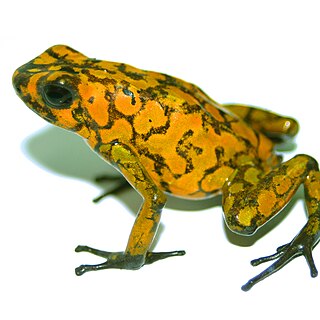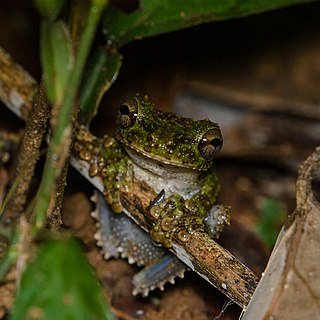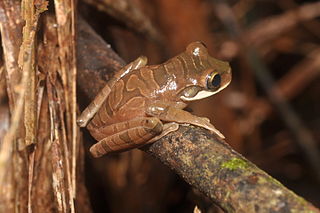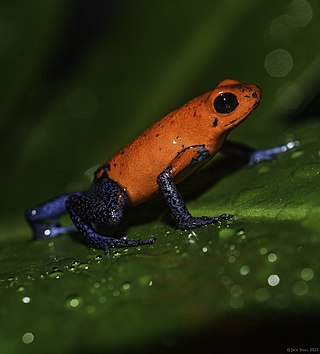
Corroboree frogs comprise two species of frog native to the Southern Tablelands of Australia. Both species are small, poisonous ground-dwelling frogs. The two species are the southern corroboree frog and the northern corroboree frog. They are unique among frogs in that they produce their own poison rather than obtain it from their food source as is the case in every other poisonous frog species.

The blue poison dart frog or blue poison arrow frog is a poison dart frog found in the "forest islands" surrounded by the Sipaliwini Savanna in southern Suriname. Its indigenous Tirio name is okopipi. The name "azureus" comes from its azur blue color. While first described as a valid species and usually recognized as such in the past, recent authorities generally treat it as a morph of D. tinctorius, although a few treat it as a subspecies of D. tinctorius or continue to treat it as its own species. To what extent it differs from the blue D. tinctorius in southern Guyana, adjacent Pará (Brazil) and possibly far southwestern Suriname, also is a matter of dispute, and many herpetologists, as well as many people keeping poison dart frogs in captivity, often have not distinguished these, with all commonly being identified as "azureus".

The strawberry poison frog, strawberry poison-dart frog or blue jeans poison frog is a species of small poison dart frog found in Central America. It is common throughout its range, which extends from eastern central Nicaragua through Costa Rica and northwestern Panamá. The species is often found in humid lowlands and premontane forest, but large populations are also found in disturbed areas such as plantations. The strawberry poison frog is perhaps most famous for its widespread variation in coloration, comprising approximately 15–30 color morphs, most of which are presumed to be true-breeding. O. pumilio, while not the most poisonous of the dendrobatids, is the most toxic member of its genus.

Oophaga sylvatica, sometimes known as its Spanish name diablito, is a species of frog in the family Dendrobatidae found in Southwestern Colombia and Northwestern Ecuador. Its natural habitat is lowland and submontane rainforest; it can, however, survive in moderately degraded areas, at least in the more humid parts of its range. It is a very common frog in Colombia, but has disappeared from much of its Ecuadorian range. It is threatened by habitat loss (deforestation) and agricultural pollution and sometimes seen in the international pet trade.

The whitebelly tree frog is a species of frog in the family Hylidae found in Ecuador and possibly Colombia and Peru. Its natural habitats are tropical and subtropical moist lowland forests, swamps, intermittent freshwater marshes, plantations, rural gardens, and heavily degraded former forests. It is threatened by habitat loss.

Osteocephalus helenae is a species of frog in the family Hylidae. It is widely distributed in the Amazon Basin and is known from the lowlands of Bolivia, Peru, Brazil, Colombia, Venezuela, Guyana, and French Guiana. The specific name helenae honors Helen Beulah Thompson Gaige, an American herpetologist. Common name Helena's [sic] treefrog has been proposed for it.

Osteocephalus buckleyi, also known as Buckley's slender-legged treefrog, is a species of frog in the family Hylidae. It is found along the periphery of the Amazon Basin in Bolivia, Peru, Ecuador, Colombia, northeastern Brazil, Venezuela, Guyana, Suriname, and French Guiana, and also in the Orinoco Delta in Venezuela. It is probably a species complex. Some sources treat Osteocephalus vilmae from Ecuador and Peru as a valid species.

Osteocephalus cabrerai is a species of frog in the family Hylidae. It is found in the Amazon Basin in Brazil (Manaus), northeastern Peru, Ecuador, Colombia, Guyana, and French Guiana, possibly wider. Some earlier records refer to Osteocephalus buckleyi.
Osteocephalus deridens is a species of frog in the family Hylidae. It is found in the Napo and Pastaza River drainages in eastern Ecuador and in the Loreto Region, northern Peru. The specific name deridens is derived from Latin deridere, meaning "make fun of someone". This alludes to the males calling from the treetops that sound "as if they are laughing at the collectors' vain attempts to reach them". Common name funny slender-legged treefrog has been coined for this species.

Henle's slender-legged tree frog is a species of frog in the family Hylidae. It is found in Peru and northeastern Bolivia. It occurs in lowland, premontane, and montane forest at elevations of 300–1,100 m (980–3,610 ft) above sea level. Breeding takes place in small streams where the tadpoles develop. It is a locally abundant species that can be threatened by habitat loss in parts of its range.
Tepuihyla exophthalma is a species of frog in the family Hylidae. It is native to Guyana and Venezuela in South America.
Osteocephalus fuscifacies is a species of frog in the family Hylidae endemic to Ecuador. It is known from the Napo River drainage at intermediate elevations. The specific name fuscifacies is derived from Latin fuscus (=tan) and facies (=face), in reference to the uniform tan-colored loreal region and the lack of a light subocular spot. Common name Napo slender-legged treefrog has been coined for this species.

The Cayenne slender-legged tree frog, also known as the Cayenne spiny-backed frog, is a species of frog in the family Hylidae found in northern South America.

Osteocephalus mutabor is a species of frogs in the family Hylidae found on the western Andean foothills of Ecuador and south to Ucayali Region of Peru. Before Osteocephalus mutabor was described as a new species in 2002, it was confused with Osteocephalus leprieurii.

The Manaus slender-legged tree frog, also known as the giant broad-headed tree frog, is a species of frog in the family Hylidae found in Bolivia, Brazil, Colombia, Ecuador, French Guiana, Guyana, Peru, Suriname, and Venezuela. Its natural habitats are subtropical or tropical dry forest, subtropical or tropical moist lowland forest, moist savanna, rivers, intermittent freshwater marshes, and canals and ditches. It is threatened by habitat loss. It is also reported to produce Bufotenin.

Osteocephalus yasuni is a species of frogs in the family Hylidae. It is found in the upper Amazon Basin in southern Colombia, Ecuador, and northeastern Peru at elevations of 70–250 m (230–820 ft) above sea level. The specific name yasuni refers to the Yasuni National Park where its type locality is.

The climbing mantella is a species of diurnal poison frog of the genus Mantella that resides in the subtropical regions of northeast Madagascar. Although it spends a significant amount of time in trees or bamboo forests, this frog species is not fully arboreal and actively seeks areas with a water source.

Oophaga is a genus of poison-dart frogs containing twelve species, many of which were formerly placed in the genus Dendrobates. The frogs are distributed in Central and South America, from Nicaragua south through the El Chocó to northern Ecuador. Their habitats vary with some species being arboreal while other being terrestrial, but the common feature is that their tadpoles are obligate egg feeders. Most species in this genus are seriously threatened and O. speciosa is already extinct.
Osteocephalus castaneicola is a species of frog in the family Hylidae. It is found in lowland Amazonia of northern Bolivia, adjacent southeastern Peru, and western Brazil. It breeds in water-filled fruit capsules of the Brazil nut, a characteristic also alluded to in its specific name castaneicola derived from the Latin castanea, the root of the vernacular name castaña for the Brazil nut, together with the Latin colō meaning "to inhabit".
















